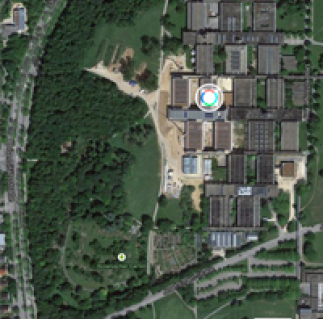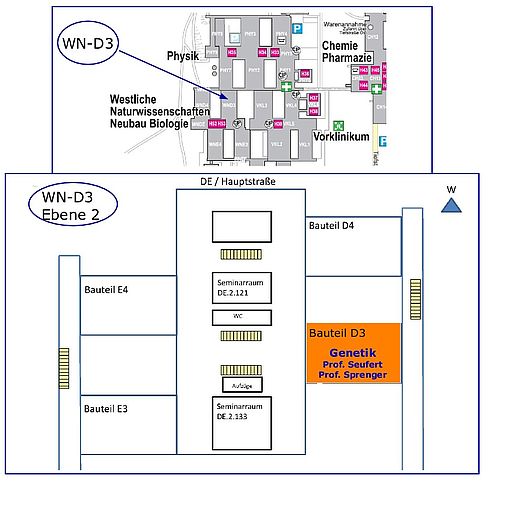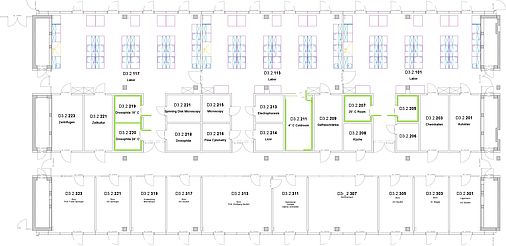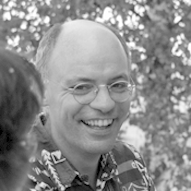Research
We study mitosis and a new link of mRNA translation to cell proliferation control
Activators of the ubiquitin ligase APC/C
Cyclin-dependent kinases (Cdks) are key regulators of the eukaryotic cell division cycle. Through phosphorylation a various target proteins, cyclinB-Cdk1 promotes early, but blocks late events of mitosis. Therefore, cyclinB proteolysis is important for the completion of nuclear and cell division. Building on work on the ubiquitin system (EMBO J 9:543-50; EMBO J 9:4535-41; TiBS 15:195-8; Nature 373:78-81), we identified a substrate recognition subunit (Hct1, a.k.a. Cdh1) of the anaphase-promoting complex (APC/C) as a regulator of cyclin B proteolysis in budding yeast (Cell 90:683-93; EMBO J 20: 5165-75). Phosphorylation by cyclin B-Cdk1 kinase was found to inhibit the APC/C-Cdh1 ubiquitination pathway (Science 282:1721-4). This antagonism is a fundamental aspect of eukaryotic cell cycle control. Recent work indicated that proteolysis by the APC/C-Cdh1 pathway is restricted to the cell nucleus in budding yeast (MBoC 26:843-58).
Nuclear localization and APC/C binding of Cdh1 were found to be controlled through separate phosphorylation sites (MBoC 27:2198-212.

Yeast Cdh1 is activated in mitosis by Cdc14 phosphatase, a protein retained in the nucleolus for most of the cell cycle. Current efforts aim to better define the underlying mechanisms, among others by mapping domains of the Net1 nucleolar Cdc14 inhibitor and the related Tof2 protein (Curr Biol 18:1001-5).
In another ongoing project we use confocal live cell imaging to study how proteins of the nucleolus are distributed during yeast mitosis. While the rDNA binding protein Fob1 segregated equally, RNA Pol I subunits and ribosome biogenesis factors predominated in the mother cell body, while other nucleolar proteins enriched in the daughter cell. We are various mutants affected in chromosome segregation or Pol I function to understand how this asymmetry in nucleolar protein segregation arises.
Cdc123 required for translation initiation and cell cycle entry
The second research focus in the lab concerns Cdc123 and the question how this protein controls entry into the cell division cycle. Cdc123 is conserved among eukaryotes and indispensable for cell viability, but its mechanism of action has remained unknown. Through genetic and biochemical analysis, we found that Cdc123 serves an unanticipated, essential role in the onset of protein synthesis by assembling the translation factor eIF2 (JBC 288:21537-46). This GTP-dependent carrier of the initiator-tRNA is well known also for its regulatory role in the stress-induced reprogramming of gene expression. In a recent collaborative effort, the 3D-structure of Cdc123 was solved (Structure 23:1596-608). The work indicated that Cdc123 is an ATP-binding protein of the ATP-grasp enzyme family. Building on the structural information, we are developing various approaches to work out the molecular mechanism of eIF2 assembly by Cdc123 and the putative regulation of the process. This project is supported by the Deutsche Forschungsgemeinschaft through SFB960.

Methods
In our work we are using a range of methods including gene cloning and mutagenesis, PCR-mediated epitope tagging, fluorescence microscopy, flow cytometry, Y2H, Western and co-IP analysis, protein affinity purification, EMSA and ThermoFluor analysis.
Team
| Team | ||
 | Prof. Dr. rer. nat.Wolfgang Seufert | |
 | Dr. rer. nat. Wolfgang Mages Gebäude Westliche Naturwissenschaften D3_2.303 | |
 | Arlett Hirsch Gebäude Westliche Naturwissenschaften D3_2.311 | |
| wissenschaftliche Mitarbeiter | ||
 | Simone Fabian Doktorandin Gebäude Westliche Naturwissenschaften D3_2.317 Tel. 0941 943-3174 Labor-Durchwahl 3177 simone.fabian@ur.de | |
 | Dr. rer. nat. Philipp Girke | |
 | Dr. rer. nat. Lea Neumann-Arnold | |
 | Dr. rer. nat. Sophia Pinz | |
 | Julia Simmler | |
| technische Mitarbeiter | ||
 | Andrea Brücher | |
 | Antje Machetanz-Morokane | |
| Kerstin Forchheim | ||
| Master und Bachelorstudenten | ||
|
| ||
| Ehemalige Mitarbeiter | ||
 | Adelheid Weissgerber Technische Assistentin | |
 | Dr. rer. nat. Franziska Wojciech | |
 | Dr. rer. nat. Sven Vanselow | |
 | Dr. rer. nat. Katharina Hannig | |
 | Dr. rer. nat. Nina Weber | |
 | Dr. rer. nat. Sebastian Höckner | |
| Wolfgang Seufert Curriculum Vitae | |
| 2004 | Full Professor and Chair at the University of Regensburg, Department of Genetics |
| 1996 - 2004 | Associate Professor at the University of Stuttgart, Institute of industrial Genetics |
| 1994 - 1996 | Heisenberg-Fellow and Group Leader at the LMU Munich, Department of Genetics |
| 1993 - 1994 | Research Fellow with Bruce Futcher at the Cold Spring Harbor Laboratory, New York, USA |
| 1988 - 1993 | Post-Doc with Stefan Jentsch at the Friedrich-Miescher-Laboratory of the Max-Planck Society in Tübingen, Germany |
| 1985 - 1988 | PhD and Diploma Studies with Walter Messer at the Max-Planck-Institute of Molecular Genetics, Berlin |
| 1981 - 1985 | Studies of Biochemistry at the Freie Universität Berlin |
Degrees
| 1995 | Habilitation in Genetics at the LMU Munich |
| 1993 | Habilitation in Biochemistry at the University of Tübingen |
| 1987 | Doctor of Natural Sciences (Dr. rer. nat.) at the FU Berlin |
Awards
| 1994 - 1996 | Heisenberg-Fellowship by the Deutsche Forschungsgemeinschaft |
| 1993 - 1994 | Research Fellowship by the Cold Spring Harbor Laboratory Association |
Publications
Cardenal P C, Vandroux P, Neumann-Arnold L, Panvert M, Fagart J, Seufert W, Mechulam Y, Schmitt E. (2023) Binding of human Cdc123 to eIF2γ. J Struct Biol. 215(3):108006. PMID 37507029. doi: 10.1016/j.jsb.2023.108006 (PubMed)
Girke P, Seufert W. (2023) Targeting of Hmo1 to subcompartments of the budding yeast nucleolus. Mol Biol Cell 34(3) (PubMed) (Mol Biol Cell)
Pinz S, Doskocil E, Seufert W (2022) Thermofluor-Based Analysis of Protein Integrity and Ligand Interactions. Methods Mol Biol 2533. 247-257. PMID 35796993. doi 10.1007/978-1-0719-2501-9_15 (PubMed)
Vanselow S, Neumann-Arnold L, Wojciech-Moock F, Seufert W (2022) Stepwise assembly of the eukaryotic translation initiation factor 2 complex. JBC 298(2) (PubMed) (JBC)
Hannig K, Babl V, Hergert K, Maier A, Pilsl M, Schächner C, Stöckl U, Milkereit P, Tschochner H, Seufert W, Griesenbeck J (2019) An activator of RNA polymerase I transcription with conserved features from yeast to human. PLoS Genetics 15(2) (PubMed) (PloS Genet)
Girke P, Seufert W. (2019) Compositional reorganization of the nucleolus in budding yeast mitosis. Mol Biol Cell 30(3) (PubMed) (Mol Biol Cell)
A Highlights from MBoC Selection
Höckner S, Neumann-Arnold L, Seufert W. (2016) Dual control by Cdk1 phosphorylation of the budding yeast APC/C ubiquitin ligase activator Cdh1. Mol Biol Cell 27(14), 2198-2212. (PubMed) (Mol Biol Cell)
A Highlights from MBoC Selection
![]() Recommended in F1000Prime
Recommended in F1000Prime
Yamano H: F1000Prime Recommendation of [Höckner S et al., Mol Biol Cell 2016 27(14):2198-2212]. In F1000Prime, 17 May 2019; 10.3410/f.726381183.793560345
Panvert M, Dubiez E, Arnold L, Perez J, Mechulam Y, Seufert W, Schmitt E. (2015) Cdc123, a Cell Cycle Regulator Needed for eIF2 Assembly, Is an ATP-Grasp Protein with Unique Features. Structure 23(9), 1596-1608. (PubMed) (Structure)
Arnold L, Höckner S, Seufert W. (2015) Insights into the cellular mechanism of the yeast ubiquitin ligase APC/C-Cdh1 from the analysis of in vivo degrons. Mol Biol Cell 26(5), 843-858. (PubMed) (Mol Bio Cell)
Perzlmaier AF, Richter F, Seufert W. (2013) Translation initiation requires cell division cycle 123 (Cdc123) to facilitate biogenesis of the eukaryotic initiation factor 2 (eIF2). J Biol Chem 288(30):21537-46. (PubMed) (J Biol Chem)
Meitinger F, Richter H, Heisel S, Hub B, Seufert W, Pereira G. (2013) A safeguard mechanism regulates Rho GTPases to coordinate cytokinesis with the establishment of cell polarity. PLoS Biol. 11(2):e1001495. (PubMed) (PLoS Biol)
Wittner M, Hamperl S, Stöckl U, Seufert W, Tschochner H, Milkereit P, Griesenbeck J. (2011) Establishment and maintenance of alternative chromatin states at a multicopy gene locus. Cell 145(4):543-54. (PubMed) (Cell)
Geil, C, Schwab, M, Seufert, W. (2008) A nucleolus-localized activator of Cdc14 phosphatase supports rDNA segregation in yeast mitosis. Current Biology 18, 1001-05. (PubMed) (Current Biology)
Dirscherl, G., Schwab, M., Seufert, W., König, B. (2008) Enhancing the separation of phosphorylated proteins in gel electrophoresis with dinuclear bispyridylmethylamine- tyrosine-acrylamide complexes. Inorganica Chimica Acta, (ScienceDirect)
Willems, A.R., Schwab, M., Tyers, M. (2004) A hitchhiker's guide to the cullin ubiquitin ligases: SCF and its kin. Biochim. Biophys. Acta 1695, 133-170 (PubMed)
Schwab, M., Tyers, M. (2001) Cell cycle. Archipelago of destruction. Nature 413, 268-269 (PubMed)
Schwab, M., Neutzner, M., Möcker, D., Seufert, W. (2001) Yeast Hct1 recognizes the mitotic cyclin Clb2 and other substrates of the ubiquitin ligase APC. EMBO J. 20, 5165-5175 (PubMed)
Menssen, R., Neutzner, A., Seufert, W. (2001) Asymmetric spindle pole localization of yeast Cdc15 kinase links mitotic exit and cytokinesis. Current Biology 11, 345-350 (PubMed)
Zachariae, W., Schwab, M., Nasmyth, K., Seufert, W. (1998) Control of cyclin ubiquitination by CDK-regulated binding of Hct1 to the anaphase promoting complex. Science 282, 1721-1724 (PubMed)
Schwab, M., Schulze Lutum, A., Seufert, W. (1997) Yeast Hct1 is a regulator of Clb2 cyclin proteolysis. Cell 90, 683-693 (PubMed)
Betting, J., Seufert, W. (1996) A yeast Ubc9 mutant protein with temperature-sensitive in vivo function is subject to conditional proteolysis by a ubiquitin- and proteasome-dependent pathway. J. Biol. Chem. 271, 25790-25796 (PubMed)
Seufert, W., Futcher, B., Jentsch, S. (1995) Role of a ubiquitin-conjugating enzyme in degradation of S- and M-phase cyclins. Nature 373, 78-81 (PubMed)
Johnson, E., Bartel, B., Seufert, W., Varshavsky, A. (1992) Ubiquitin as a degradation signal. EMBO J. 11, 497-505 (PubMed)
Seufert, W., Jentsch, S. (1992) In vivo function of the proteasome in the ubiquitin pathway. EMBO J. 11, 3077-3080 (PubMed)
Seufert, W., McGrath, J.P., Jentsch, S. (1990) UBC1 encodes a novel member of an essential subfamily of yeast ubiquitin-conjugating enzymes involved in protein degradation. EMBO J. 9, 4535-4541 (PubMed)
Seufert, W., Jentsch, S. (1990) Ubiquitin-conjugating enzymes UBC4 and UBC5 mediate selective degradation of short-lived and abnormal proteins. EMBO J. 9, 543-550 (PubMed)
Seufert,W., Jentsch, S. (1990) Nucleotide sequence of two tRNAArg-tRNAAsp tandem genes linked to duplicated UBC genes in Saccharomyces cerevisiae. Nucleic Acids Res. 18, 1638 (PubMed)
Seufert, W. (1990) Nucleotide sequence of the yeast SDH1 gene encoding a serine dehydratase homolog. Nucleic Acids Res. 18, 3653 (PubMed)
Seufert, W., Lurz, R., Messer, W. (1988) A novel replicon occuring naturally in Escherichia coli is a phage-plasmid hybrid. EMBO J. 7, 4005-4010 (PubMed)
Seufert, W., Dobrinski, B., Lurz, R., Messer, W. (1988) Functionality of the DnaA protein binding site in DNA replication is orientation dependent. J. Biol. Chem. 263, 2719-2723 (PubMed)
Seufert, W., Messer, W. (1987) Start sites for bidirectional in vitro replication inside the replication origin, oriC, of Escherichia coli. EMBO J. 62469-2472 (PubMed)
Seufert, W., Messer, W. (1987) DnaA protein binding to the plasmid origin region can substitute for primosome assembly during replication of pBR322 in vitro. Cell 48, 73-78 (PubMed)
Seufert, W., Messer, W. (1986) Initiation of Escherichia coli minichromosome replication at oriC and protein n’ recognition sites.Two modes for initiating DNA synthesis in EMBO J.5, 3401-3406 (PubMed)
Teaching
Vorlesungen
| Vst.-Nr. | Veranstaltung | Termine |
| 54119
54120 | Genetik
Übung zur Vorlesung | Mi 09:00-10:00 Do 09:00-11:00 Mi 10:00-11:00 |
| 54130 | Einführung in die Biochemie, Mikrobiologie und Genetik | Di 08:15-09:00 Fr 08:15-09:45 |
| 54402 | Special lecture: Cell Cycle Control in Eukaryotes | Wintersemester Do 08:30-10:00 |
| 54650 | Special lecture: Molecular Cell Biology | Wintersemester Mo 18:00-19:30 |
Praktika
| 54123 | Genetik - Wahlpflichtpraktikum |
| Experimente zu Entstehung, Nachweis und Reparatur von Mutationen; Erbmusteranalyse; gezielte Deletion eines Gens; DNA-Präparation; heterologe Genexpression; PCR-vermittelte Genotypisierung Detaillierte Angaben im Praktikumsskript zugänglich in GRIPS | |
| 54131 | Genetisch-Mikrobiologisches Praktikum für nicht vertieftes Fachstudium |
| Mikrobiologie: | |
| 54420 | Forschungspraktikum: Genetik - Regulation der Zellteilung in der Hefe |
| Mitarbeit in einem laufenden Forschungsprojekt. Siehe Webseite der Arbeitsgruppe - Prof. Seufert! | |
| 54422 | Forschungspraktikum: Genetik - Regulation der Zellteilung in Drosophila |
| Mitarbeit in einem laufenden Foschungsprojekt zur Zellyzkluskontrolle in Drosophila. Siehe Webseite der Arbeitsgruppe - Prof. Sprenger! | |
| 54424 | Laborpraktikum: Genetik - Regulation der Zellteilung in der Hefe |
| Participation in a scientific project. Methods: DNA cloning and mutagenesis, gene expression, Western analysis, co-immunoprecipitation, protein affinity purification, EMSA, Y2H, cell synchronization, flow cytometry, fluorescence microscopy, life cell imaging | |
| 54425 | Laborpraktikum: Genetik - Regulation der Zellteilung in Drosophila |
| Students will participate in an ongoing project on cell cycle control in Drosophila. Typically, this involves overexpression or knock-down (RNAi) of cell cycle control proteins in tissue culture cells or Drosophila embryos and analysis of the cell cycle by flow cytometry or live cell imaging using confocal laser microscopy. Construction of modified DNA-plasmids encoding altered cell cycle proteins for use in the aforementioned experiments will be performed using molecular biology techniques. | |
Seminare
| 54414 | Seminar zum Laborpraktikum: Regulation der Zellteilung in der Hefe |
| Vorstellung von aktuellen Arbeiten aus dem Bereich Zellzykluskontrolle in Hefe | |
| 54415 | Seminar zum Laborpraktikum: Regulation der Zellteilung in Drosophilla |
| Vorstellung von aktuellen Arbeiten aus dem Bereich Zellzykluskontrolle in Drosophila | |
| 54427 | Literature Seminar: Cell Cycle Control Mechanisms in Eukaryotes |
| Literature Seminar to Lecture 54402 Presentation of selected topics /papers | |
Contact
| Prof. Dr. Wolfgang Seufert | ||||
| google map position |  | |||
| Lageplan Neubau Biologie (Westliche Naturwissenschaften)
Lageplan Räume Genetik
How to get there The University has a good "How to get there" page:
| ||||




